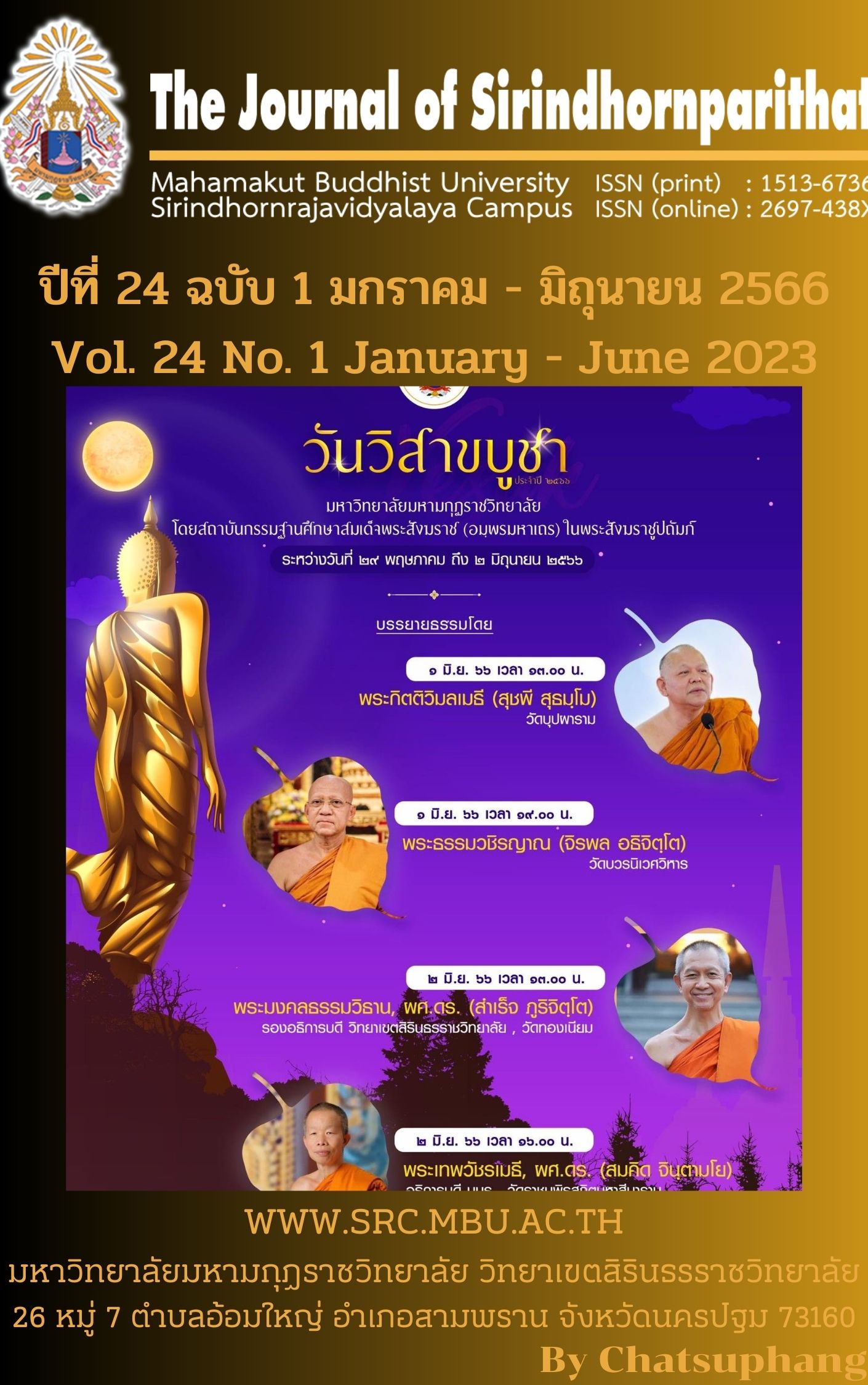Proposed guidelines for participation development of public and non-governmental organizations in the formulation of Thai education policy
Keywords:
Participation, Policy Making, Public, Private Sector OrganizationsAbstract
The objectives of this research were to 1) Synthesize the current engagement practices for educational policy formulation in Thailand 2) Construct a participation model of public and non-governmental organizations in the formulation of Thai educational policy and 3) Confirm a participation model of public and non-governmental organizations in the formulation of Thai educational policy. This research applied mixed methods research. The sampling size (Respondents) are educational persons of 425 Informants, representing 85% from educational agencies across the country. The research instrument used a questionnaire with a 5-rating scale, and the results of validity between 0.6 – 1.0 and Cronbach’s Alpha shown reliability at 0.994. The statistics were mean, percentage, standard deviation, skewness, kurtosis and factor analysis; Exploratory Factor Analysis (EFA) and Confirmatory Factor Analysis (CFA).
The research findings found
1) A current practice in formulating an educational policy were 1.1) Drafting an educational policy from government officials in various ministries, Departments, and Bureau units that depends on the political system, which drafting in a short time period. It created and prepared by forming a “working group” which assigned by the government and representatives of government agencies as key informants to provide inputs for instance problems and need in order to prepare a draft policy 1.2) Policy approval that applied a Cabinet resolution as a mechanism to mutually make a decision on policy drafting. 1.3) Policy driven, this process will be appointed a committee of policy advocacy 1.4) Policy Implementation, it applied a mechanism as an issue a legislation that allows all agencies to participation and practice in policy engagement both national and provincial level and educational institution
2.The participation model of public and non-governmental organizations in the formulation of Thai educational policy were analyzed by the factor analysis i.e., (EFA) constructed results of 5 factors were: 1) Participation in addressing the need and analysis 2) Participation in academic and research 3) Participation in perceptive agree 4) Participation in policy compliance 5) Participation in policy advocacy. They had factor loading between 0.630-0.727, eigenvalues=66.284, percentage of variance=39.319, the cumulative % Variance= 51.792 3) CFA concluded the participation model were examined by relative Chi-Square=1.239, df=52, it had a statistic significant at 0.115. The hypothetical model was consistency with the empirical data (ß=0)at the 0.05-statistically significant level. Concordance indexes found GFI=0.982, AGFI=0.952, TLI= 0.992, NFI=0.982, CFI=0.997, greater than 0.95. Estimation error indexes: SRMR=0.0342, RMR=0.038, RMESA=0.024, are less than 0.05.
References
กลุ่มนโยบายและแผน. (2564). แผนที่นำทางการขับเคลื่อนเป้าหมายการพัฒนาที่ยั่งยืนด้านการศึกษา (SDG4) จังหวัดสมุทรปราการ: สำนักงานศึกษาธิการจังหวัดสมุทรปราการ.
คณะกรรมการร่างรัฐธรรมนูญ สำนักงานเลขาธิการสภาผู้แทนราษฎร. (2560). ราชกิจจานุเบกษา (เล่ม 134 ตอนที่ 40ก). กรุงเทพฯ: สำนักงานเลขาธิการสภาผู้แทนราษฎร.
ธีรวุฒิ เอกะกุล. (2543). ระเบียบวิธีวิจัยทางพฤติกรรมศาสตร์และสังคมศาสตร์. อุบลราชธานี: สถาบันราชภัฎอุบลราชธานี.
สมเกียรติ ตั้งกิจวานิชย์. (2563). ระบบการศึกษาต้องเร่งปรับตัวในโลกที่กำลังพลิกพัน. กสศ. ค้นเมื่อ, มกราคม 8, 2564, จาก https://www.eef.or.th/interview-somkiat/
สำนักงานสภาพัฒนาการเศรษฐกิจและสังคมแห่งชาติ (สศช.). (2564). สภาพัฒน์จัดระดมความคิดเห็นต่อร่างแผนฯ 13 ในการประชุมประจำปี 2564 Mission to Transform : 13 หมุดหมายพลิกโฉมประเทศไทย. ข่าวสาร/กิจกรรม. ค้นเมื่อ, 18 ตุลาคม 2564, จาก www.nesdc.go.th
สำนักนโยบายและแผนการศึกษาขั้นพื้นฐาน. (2560). นโยบาย ปีงบประมาณ พ.ศ. 2560 สำนักงานคณะกรรมการการศึกษาขั้นพื้นฐาน. กรุงเทพฯ: สำนักงานคณะกรรมการศึกษาขั้นพื้นฐาน.
อรทัย ก๊กผล. (2552). คู่คิด คู่มือการมีส่วนร่วมของประชาชน สำหรับนักบริหารท้องถิ่น. กรุงเทพฯ: จรัญสนิทวงศ์การพิมพ์.
Arnstein, S. R. (1969). A Ladder Of Citizen Participation. Journal of the American Institute of Planners, 35, 216-224.
Best, J. W. (1977). Research in Education (3rd ed.). Englewood Cliffs, New Jersey: Prentice Hall.
Cochran, W. G. (1977). Sampling Techniques (3rd ed.). New York: John Wiley & Sons, Inc.
Diamantopoulos, A., & Siguaw, J. A. (2000). Introducing LISREL: A guide for the uninitiated. London: SAGE Publications, Inc,.
Kaiser, H. F. (1974). An index of factorial simplicity. psychometrika, 39(1): 31-36. doi:10.1007/BF02291575
Likert, R. (1932). A technique for the measurement of attitudes. Archives of psychology.
Schumacker, R. E., & Lomax, R. G. (2010). A beginner's guide to structural equation modeling (3rd ed.). New Jersey: Lawrence Erlbaum Associates.

Downloads
Published
Issue
Section
License
Copyright (c) 2023 Mahamakut Buddhist University

This work is licensed under a Creative Commons Attribution-NonCommercial-NoDerivatives 4.0 International License.
บทความที่ได้รับการตีพิมพ์เป็นลิขสิทธิ์ของ มหาวิทยาลัยมหามกุฏราชวิทยาลัย วิทยาเขตสิรินธรราชวิทยาลัย
ข้อความที่ปรากฏในบทความแต่ละเรื่องในวารสารวิชาการเล่มนี้เป็นความคิดเห็นส่วนตัวของผู้เขียนแต่ละท่านไม่เกี่ยวข้องกับหาวิทยาลัยมหามกุฏราชวิทยาลัย วิทยาเขตสิรินธรราชวิทยาลัย และคณาจารย์ท่านอื่นๆในมหาวิทยาลัยฯ แต่อย่างใด ความรับผิดชอบองค์ประกอบทั้งหมดของบทความแต่ละเรื่องเป็นของผู้เขียนแต่ละท่าน หากมีความผิดพลาดใดๆ ผู้เขียนแต่ละท่านจะรับผิดชอบบทความของตนเองแต่ผู้เดียว



